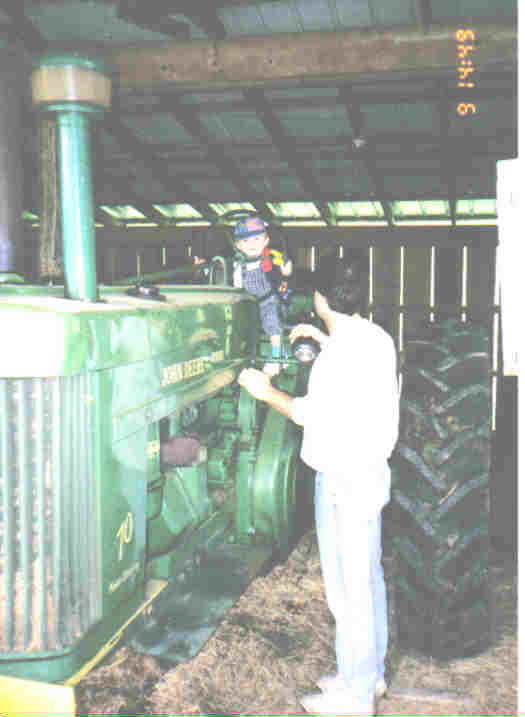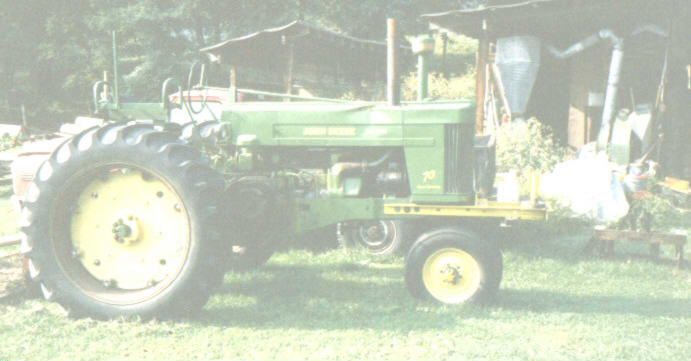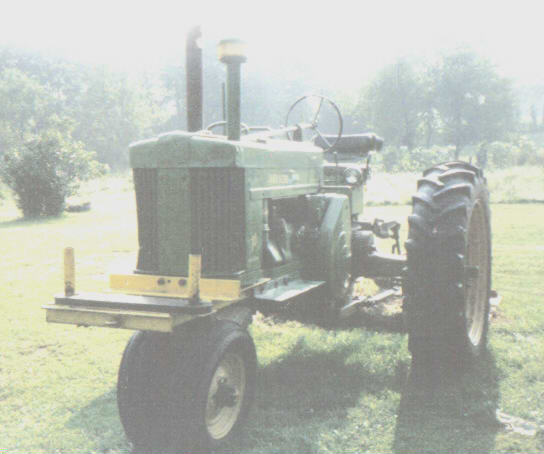A big advance in
Horsepower over the G
was the Model 70 Tractors
|
|
Deere's first row crop Diesel - the Model 70 Tractor
John Deere manufactured the model 70 from 1953 to 1956.
New power steering available for the first time on the 50, 60 and 70.
The John Deere Model 70 Tractor....Born to Pull
Replacing the John Deere Model G, the John Deere Model 70 Tractor
was nothing like the G. It had an all new engine, much improved
operator features and comfort, better hydraulics, live PTO, power
steering, rack and pinion rear tread adjustment and a 12 volt
electrical system.
The 70 retained the high low transmission from the G.
The Model G had only been offered with an all fuel engine with just
under 40 horsepower. Farmers welcomed the addition of a gasoline
engine on the 70 which put out a bit over 50 horses.
Not only did the Model 70 provide horsepower, it also broke the all
time fuel economy record at Nebraska beating the John Deere Model R Diesel.
Variations of the John Deere 70 Tractor:
Model 70
Model 70 Standard
Model 70 Hi Crop
Model 70 Diesel (row crop, standard and hi crop)
The original gas Model 70 had a bore and stroke of 5 7/8 x 7 inch
stroke, 379 cid, 975 rpm, 44.2 drawbar and 50.4 belt horsepower.
The 70 being "driven" by our nephew Tyler

The John Deere 70 Diesel Tractor
In November 1954 the Model 70 Diesel tractor was introduced. It
was Deere's first row crop diesel tractor. The engine had a
6 1/8 bore and 6 3/8 stroke, 376 cid, 1,125 rpm, 54.7 drawbar and
51.5 belt horsepower. The addition of a center main bearing for
the crankshaft helped keep the crankshaft in place
and provided better balance for the engine.
A new 4 cylinder pony motor design was used for starting the main
engine. It had a bore and stroke of 2 x 1 1/2 inches, 18.8 cid and
turned at a high 5500 rpm.
Starting the diesel engine was accomplished by pulling a single lever
towards the operator which allowed the pony motor to engage the
flywheel ring gear and turn the diesel engine. Once the diesel was
turning, the lever would then be moved partially forward which put
the diesel on full compression and start.
The pony motor was started by pushing the lever forward. On later
models a foot pedal was provided to engage the 6 volt starting
motor on the pony.
Our 1955 Model 70 Diesel

This was before we replaced the pony motor with a 24 volt
electrical starting system. Note also the John Deere belt driven
hammer mill in the right hand side of the photo. Also take note
of the custom made seat we installed for our son Karl that was
bolted on the flywheel side of the rear axle. It had a seat belt and
provision for an umbrella.....definitely not factory parts
This particular tractor was originally sold very near Waterloo Iowa
where it was manufactured.
It was then resold to a private owner near Washington, Pa. It came to
him from Iowa with rear duals leading us to believe it had been used as
a plow tractor. The second owner used it for general farm use and
for pulling. According to it's second owner, it had never been left
out a single night without being covered. We continued this tradition
as much as possible.
The ding in the hood is from the tractor sliding down a hill when
the second owner was brush hogging and being stopped by a fence post.
Note: the 70 was not much of a hillside tractor. The gearing was
too fast and it didn't have much "stickability" as we took several
unexpected rides down a hill. That led us to purchasing a 720
Diesel with wide front end, which did a great job of sticking on
these hills in southwestern Pennsylvania.
We purchased the tractor for $2,100 in 1993 as it's third and most likely
last owner. We did a major overhaul on the engine in 94. It was bored
at 90 over. Roger Marlin of 2 Cylinder Diesel Shop redid the
injectors. We have a standard bore 720 Diesel
and we believe
the 70 has as much power as the 720.
In 94 we also replaced the pony motor with a 24 volt electrical
system that came from a junked 730. What a mess that was trying
to figure out how the 24 volt system worked and get it to functioning
properly. It installed like a breeze, but took us months and lots of
phone calls to figure it out. Really the only major change we did to
put the electrical system on was cut the divider out of the battery
box to accommodate the two 12 volt batteries, and change the
generator bracket. Everything else bolted right in place.
See our
explanation of the John Deere 24 Volt Electrical System

Note: the pre cleaner is from a 4020 and was put on
by the tractors second owner.
John Deere 70 Trivia
The 50 and 60 were introduced in June 1952, the 70 came out in April
1953 with a gasoline or all fuel engine.
Yellow seat cushions weren't offered on John Deere two cylinder tractors
until the 20 series, original equipment was black cushions.
A new 1956 Model 70 row crop tractor with gasoline engine cost $2692.
Shipping weight was 6,035 pounds for the gas and 6,510 for the diesel.
Only 25 Model 70 LP Gas Hi crops were ever built, 16 gasoline,
70 all fuel and 44 diesels.
41,030 Model 70's were built of all variations.
A common problem on the 70, 720 and 730 diesels was that over time,
the flywheel would become loose on the crankshaft. The flywheel
was softer metal than the crank and both were splined with only one key.
As the diesel engine was shut off it would do a lot of rocking and a
final big rock backwards as the engine would try to make that last
revolution over compression.
This put tremendous pressure on the splines, which really weren't big
enough to take the stress over the years.....the one major design fault
on these tractors.
Prevention is easily accomplished by shutting off the diesel (pulling the
speed control lever all the way rearward), and then releasing compression
in the engine with the decompression lever. This eliminated a large
amount of the rocking, thus saving wear and tear on the splines.
Our 70 Diesel above had a previously installed taper lock flywheel.
All Model 70 Diesel tractors had the pony motor from the factory.
However, rebuilding a pony is a very, very expensive proposition.
The 24 volt electric starting system on the 720 and 730 will fit
almost exactly on a 70.
There is basically no difference in the frame and mounting holes for
the pony and 24 volt electrical system on any of the 3 models. The generator
bracket will need to be replaced as the 70 had a 6 volt generator for
the pony, light bulbs will need to replaced to 12 volt, and the divider in
the battery box will need to be cut out.
Many 720 & 730 Diesels had the same pony motor as starting equipment.
Next:
John Deere 80
Back to:
John Deere 60
Return to: John Deere Tractors
|